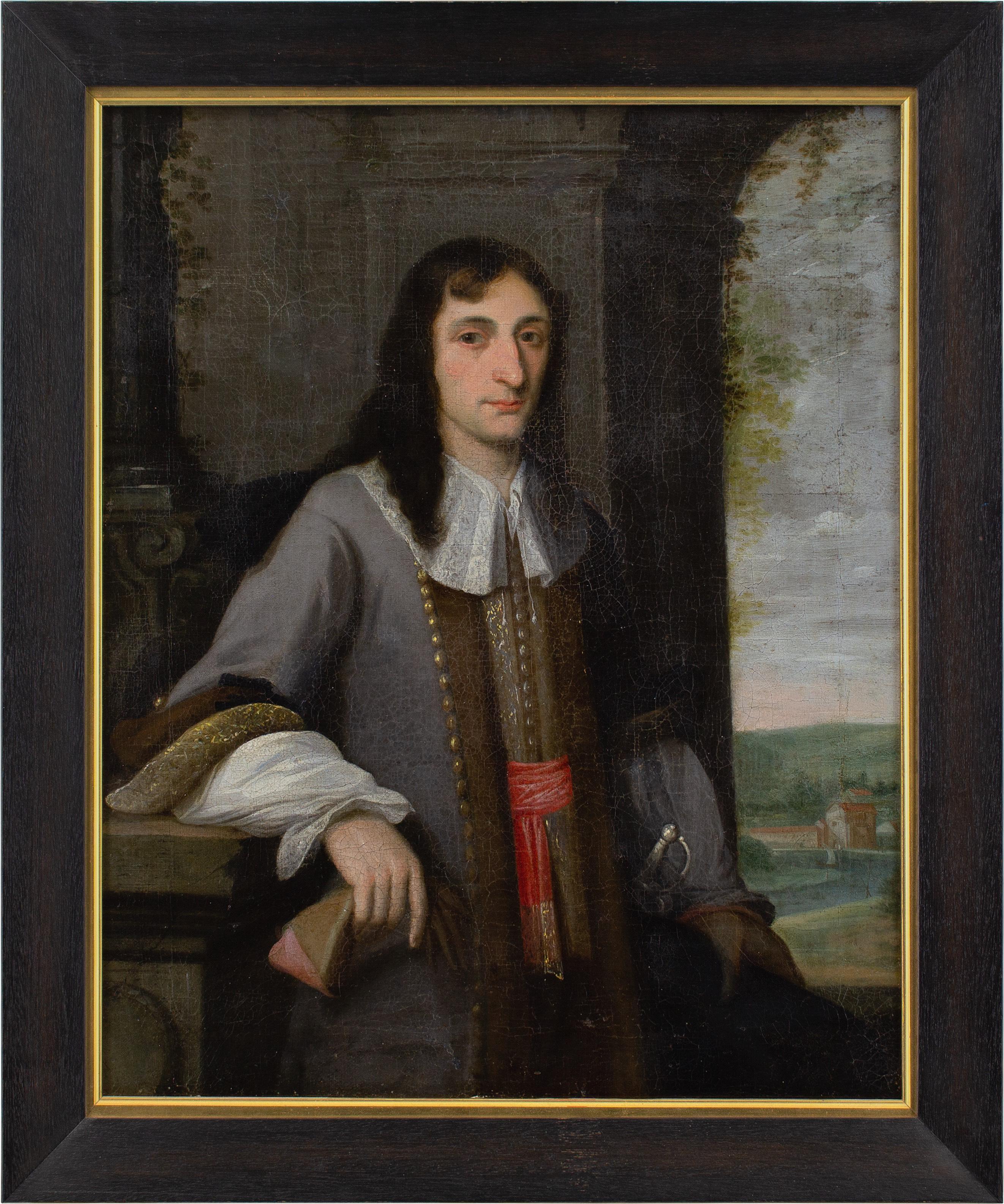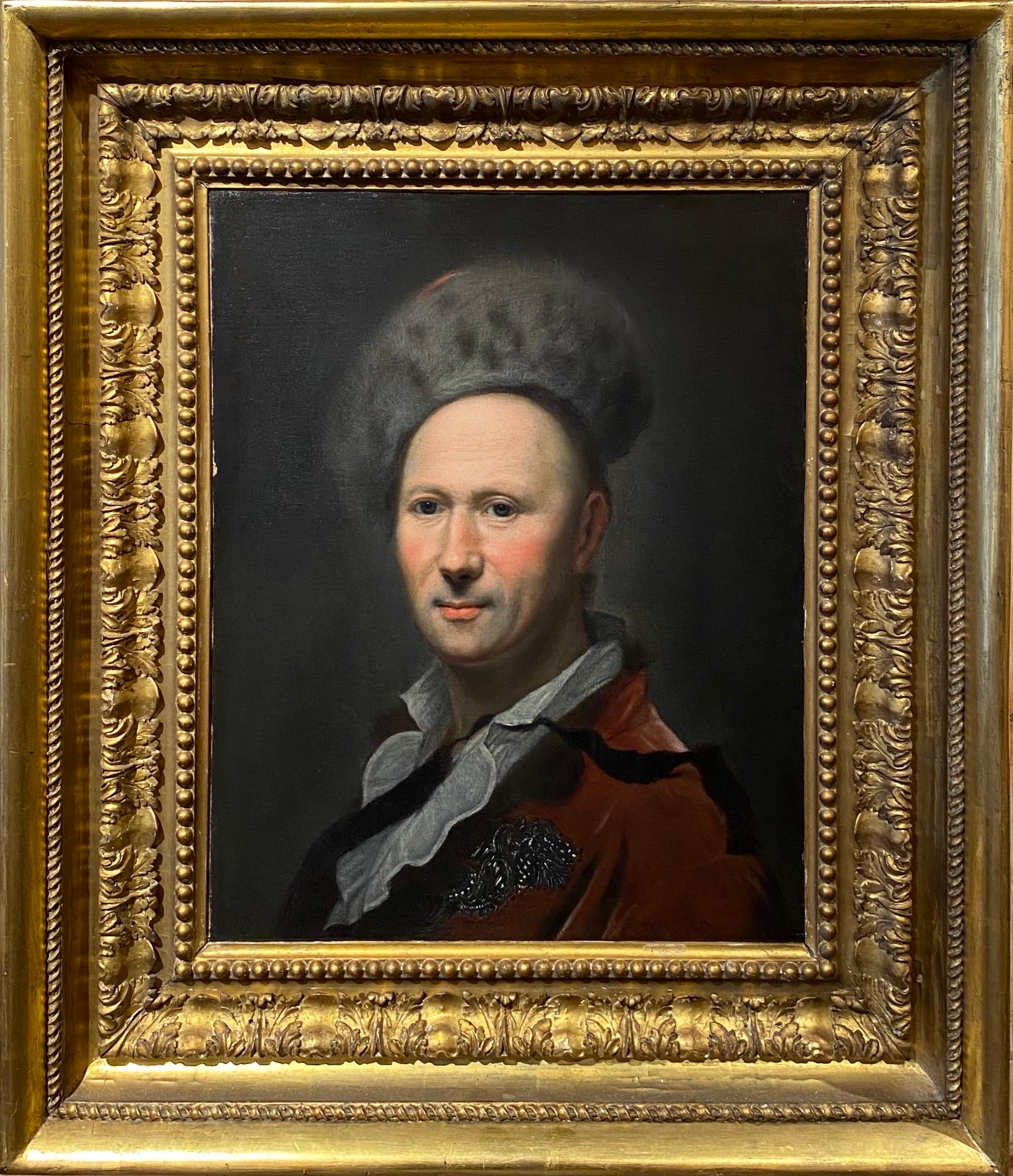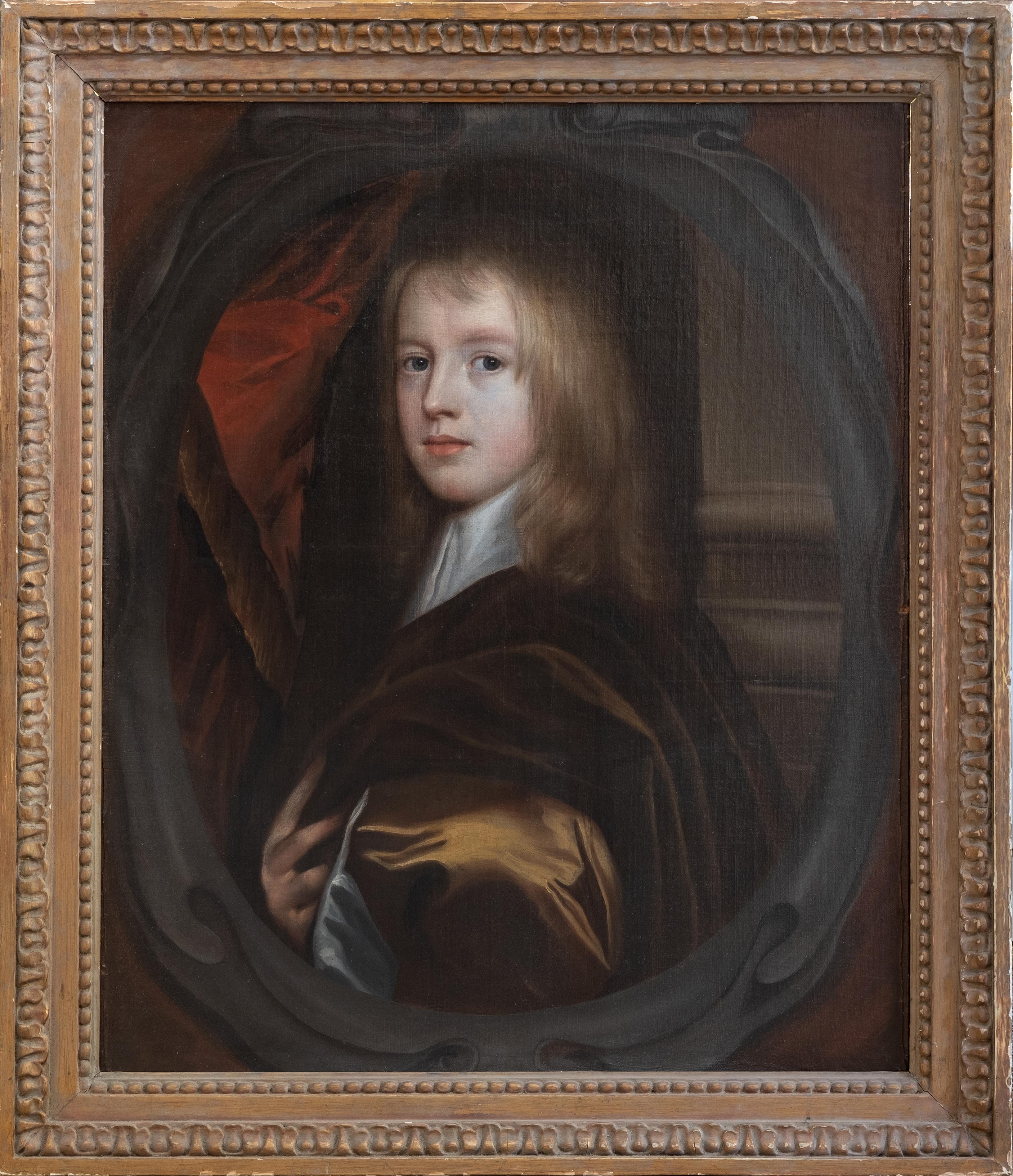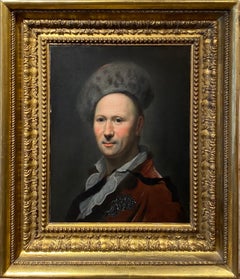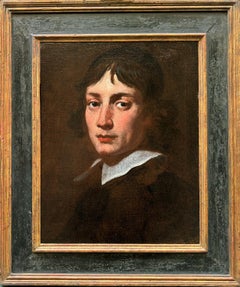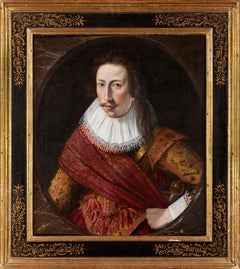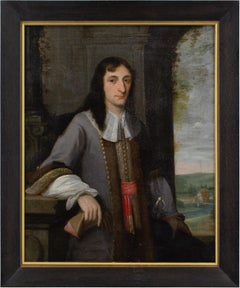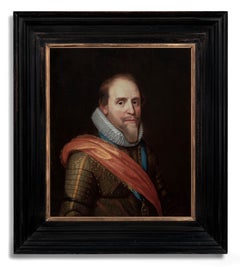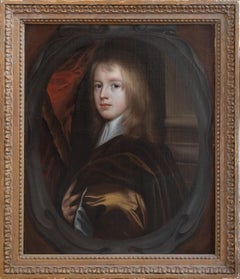Items Similar to Portrait of Nicholas Poyntz
Want more images or videos?
Request additional images or videos from the seller
1 of 5
Remigius Van LeemputPortrait of Nicholas Poyntz
$44,222.11
£32,500
€37,973.57
CA$61,148.12
A$66,552.60
CHF 35,563.33
MX$803,701.49
NOK 446,944.03
SEK 415,709.95
DKK 283,680.42
About the Item
Remigius Van Leemput
Portrait of Nicholas Poyntz
1607-1675
Oil on oak panel, unsigned
Image size: 13 x 10 1/4 inches (33 x 26 cm)
Contemporary style frame
Provenance
The Dalva Brothers Collection
Sir Nicholas Poyntz
Sir Nicholas Poyntz (1510-1556) was a prominent English Courtier and landowner during the later part of Henry VIII’s reign. Poyntz was a supporter of the dissolution of the monasteries and the religious change under Henry VIII for which he received his knighthood. His loyalty to the crown was confirmed by Henry VIII and Anne Boleyn’s visit to his lodgings at Acton Court, Gloucestershire.
In anticipating this visit, Poyntz had built new rooms for his royal guests, all of which still remain today. Poyntz’s dedication to the throne was also exemplified through his presence at court for important state occasions, such as the christening of Prince Edward, the arrival of Anne of Cleves, and the welcoming of the Admiral of France in 1546.
In 1539 and 1545 he served as High Sheriff of Gloucestershire, later representing Gloucestershire in Parliament as a Knight of the Shire in 1547 before marrying Joan, the daughter of soldier and aristocrat Thomas Berkeley, 5th Baron of Berkley. Nicholas Poyntz’s marriage into the Berkeley family involved him in frequent litigation with his wife’s kinsmen over her claim to certain property. He was also sued in the Star Chamber for assault and for poaching and in 1533, as steward to the bishop of Worcester in Gloucestershire, he was accused of holding courts and taking fines without his master’s permission.
Poyntz had become a soldier at an early age. In 1534 he fought in Ireland under Sir John St. Loe. In 1536 he served under Sir William Kingston during the northern rebellion: early in 1543 he was assigned to go with Sir Robert Bowes to the Netherlands, but by July he was in command of a patrol guarding the Bristol Channel and its approaches.
During the war of the Rough Wooing, part of the Anglo-Scottish wars of the sixteenth century following the English Reformation, Poyntz commanded the warship the Great Gallery and later in May 1544 under command of the Earl of Hertford, burnt down Kinghorn and other towns in Fife while Edinburgh was sacked and burnt by the English.
Remigius Van Leemput
Remigius Van Leemput, known in England as Remeee, was a Flemish portrait painter, copyist, collector and art dealer. Born in Antwerp, Leemput trained in the local Guild of Saint Luke as a pupil of Frans van Lanckvelt the Elder between 1618 and 1619.
Leemput spent a lot of his time in England and was a key collaborator of Sir Anthony Van Dyck during Van Dyck’s final stay in London. Gaining a prominent position in the London art world, Leemput became an art dealer and major collector of paintings and drawings. However, after the execution of Charles I of England in 1649, his art collection was broken up and sold off in order to repay the debtors of the former king.
Leemput was known for his original works as well as for his small-scale copies after van Dyck, Lely and others. In 1667 Leemput was commissioned by Charles II to make a small copy of the wall painting by Hans Holbein the Younger representing Henry VII, Elizabeth of York, Henry VIII and Jane Seymour at the Palace of Whitehall in London for his own collection.
Museums
The Royal Collection
National Portrait Gallery
- Creator:Remigius Van Leemput (1607 - 1675, Belgian)
- Dimensions:Height: 13 in (33.02 cm)Width: 10.25 in (26.04 cm)
- Medium:
- Movement & Style:
- Period:
- Condition:
- Gallery Location:London, GB
- Reference Number:1stDibs: LU52415815102
About the Seller
5.0
Gold Seller
Premium sellers maintaining a 4.3+ rating and 24-hour response times
Established in 2007
1stDibs seller since 2014
85 sales on 1stDibs
Typical response time: 4 hours
- ShippingRetrieving quote...Shipping from: London, United Kingdom
- Return Policy
More From This Seller
View AllPortrait of Conrad Friedrich Hurlebusch, Early 18th Century Oil Painting
By Dominicus van der Smissen
Located in London, GB
Dominicus van der Smissen
Early 18th Century
Portrait of Conrad Friedrich Hurlebusch
Oil on canvas
Image size: 20½ x 16¼ inches
Period gilt frame
This is a portrait of Conrad Friedrich Hurlebusch, composer, Kapellmeister and organist, whom Van der Smissen most probably portrayed during his stay in Hamburg, Brunswick or Amsterdam. The identification is based on the reproduction of the portrait which was engraved by Pieter Anthony Wakkerdak (1740- 1774).
Van der Smissen has reduced the face of the sitters to an egg-shaped oval in three-quarter view, applying diminution to one half of the figure’s torso, which is farther away from the viewer. This partial side view, with the head turned to look at the viewer over the shoulder, creates spatial depth and brings the figure to life by avoiding the stiffness of a frontal depiction.
Because the artist chose to highlight the figure from above, a distinct shadow is cast under the tip of the nose, in the shape of a triangle. This is an often recurring and almost ‘signature’-like feature in Van der Smissen’s oeuvre.
Hurlebusch's garments are of a very high quality and serve to reflect the sitter’s wealth, status and elegance. During this period, gentlemen often shaved their heads in order to facilitate the wearing of a wig, which wouldbe worn with a suit. Here Hurlebusch has been depicted in a luxurious turban-like cap lined with lynx fur, a highly fashionable and expensive material at the time.
Over his shirt, he wears a velvet fur-lined gown adorned with decorative clasps fashioned from silver braid. The elegant informality of his appearance can be seen in his unbuttoned shirt and the unfastened black ribbon hanging from his button hole, which has been artfully arranged into a fluttering drape by the portraitist.
The Sitter
Hurlebusch was born in Brunswick, Germany. He received the first instructions in his field from his father Heinrich Lorenz Hurlebusch, who was also a musician. As an organ virtuoso, he toured Europe, visiting Vienna, Munich and Italy.
From 1723 to 1725 he was Kapellmeister in Stockholm; later he became Kapellmeister in Bayreuth and Brunswick, and lived in Hamburg from 1727 to 1742, where he had contact with fellow composers Johann Mattheson and Georg Philipp Telemann. He made his living composing, performing and teaching.
In 1735 and 1736, he is believed to have visited Johann Sebastian Bach in Leipzig, who promoted Hurlebusch’s compositions as the local seller...
Category
Early 18th Century Old Masters Portrait Paintings
Materials
Canvas, Oil
Portrait of William Herbert, 3rd Earl of Pembroke, Early 17th Century Portrait
Located in London, GB
English School, (circa 1600)
Portrait of William Herbert, 3rd Earl of Pembroke
Oil on panel, oval
Image size: 29¼ x 23⅞ inches
Painted wooden frame
Provenance:
176, Collection of Francis Greville, 1st Earl of Warwick.
The Trustees of the Lord Brooks’ Settlement, (removed from Warwick Castle).
Sotheby’s, London, 22nd March 1968, lot 81.
Painted onto wooden panel, this portrait shows a dark haired gentleman in profile sporting an open white shirt. On top of this garments is a richly detailed black cloak, decorated with gold thread and lined with a sumptuous crimson lining. With the red silk inside it’s all very expensive and would fall under sumptuary laws – so this is a nobleman of high degree.
It’s melancholic air conforms to the contemporary popularity of this very human condition, evident in fashionable poetry and music of the period. In comparison to our own modern prejudices, melancholy was associated with creativity in this period.
This portrait appeared in the earliest described list of pictures of Warwick castle dating to 1762. Compiled by collector and antiquary Sir William Musgrave ‘taken from the information of Lord & Lady Warwick’ (Add. MSS, 5726 fol. 3) is described;
‘8. Earl of Essex – an original by Zuccharo – seen in profile with black hair. Holding a black robe across his breast with his right hand.’
As tempting as it is to imagine that this is a portrait of Robert Devereux, the 2nd Earl Essex, we might take this with a pinch of salt. Its identification with this romantic and fatal Elizabethan might well have been an attempt to add romance to Warwick Castle’s walls. It doesn’t correspond all that well with Essex’s portraits around 1600 after his return from Cadiz. Notably, this picture was presumably hung not too far away from the castle’s two portraits of Queen Elizabeth I. The first, and undoubtedly the best, being the exquisite coronation portrait that was sold by Lord Brooke in the late 1970s and now hangs in the National Portrait Gallery. The second, described as being ‘a copy from the original at Ld Hydes’, has yet to resurface.
The portrait eventually ended up being hung in the State Bedroom of Warwick Castle.
Archival documents present one other interesting candidate. The Greville family’s earliest inventory of paintings, made in 1630 at their home Brooke House in Holborn, London, describes five portraits of identified figures. All five belonged to the courtier, politician and poet Sir Fulke Greville (1554-1628), 1st Baron Brooke, and were hung in the ‘Gallerie’ of Brooke House behind yellow curtains. One of them was described as being of ‘Lord of Pembrooke’, which is likely to have been William Herbert (1580-1630), 3rd Earl of Pembroke. William was the eldest son of Greville’s best friend’s sister Mary Sidney, and was brought up in the particularly literary and poetically orientated household which his mother had supported. Notably, the 3rd Earl was one of the figures that Shakespeare’s first folio was dedicated to in 1623.
The melancholic air to the portrait corresponds to William’s own pretensions as a learned and poetic figure. The richness of the robe in the painting, sporting golden thread and a spotted black fabric, is indicative of wealth beyond that of a simple poet or actor. The portrait’s dating to around the year 1600 might have coincided with William’s father death and his own rise to the Pembroke Earldom. This period of his life too was imbued with personal sadness, as an illicit affair with a Mary Fitton had resulted in a pregnancy and eventual banishment by Elizabeth I to Wilton after a short spell in Fleet Prison. His illegitimate son died shortly after being born. Despite being a close follower of the Earl of Essex, William had side-stepped supporting Devereux in the fatal uprising against the Queen and eventually regained favour at the court of the next monarch James I.
His linen shirt is edged with a delicate border of lace and his black cloak is lined on the inside with sumptuous scarlet and richly decorated on the outside with gold braid and a pattern of embroidered black spots.
Despite the richness of his clothes, William Herbert has been presented in a dishevelled state of semi-undress, his shirt unlaced far down his chest with the ties lying limply over his hand, indicating that he is in a state of distracted detachment. It has been suggested that the fashion for melancholy was rooted in an increase in self-consciousness and introspective reflection during the late 16th and early 17th centuries.
In contemporary literature melancholy was said to be caused by a plenitude of the melancholy humor, one of the four vital humors, which were thought to regulate the functions of the body. An abundance of the melancholia humor was associated with a heightened creativity and intellectual ability and hence melancholy was linked to the notion of genius, as reflected in the work of the Oxford scholar Robert Burton, who in his work ‘The Anatomy of Melancholy’, described the Malcontent as ‘of all others [the]… most witty, [who] causeth many times divine ravishment, and a kind of enthusiamus… which stirreth them up to be excellent Philosophers, Poets and Prophets.’ (R. Burton, The Anatomy of Melancholy, London, 1621 in R. Strong, ‘Elizabethan Malady: Melancholy in Elizabethan and Jacobean Portraits’, Apollo, LXXIX, 1964).
Melancholy was viewed as a highly fashionable affliction under Elizabeth I, and her successor James I, and a dejected demeanour was adopted by wealthy young men, often presenting themselves as scholars or despondent lovers, as reflected in the portraiture and literature from this period. Although the sitter in this portrait is, as yet, unidentified, it seems probable that he was a nobleman with literary or artistic ambitions, following in the same vain as such famous figures as the aristocratic poet and dramatist, Edward de Vere...
Category
Early 17th Century Old Masters Portrait Paintings
Materials
Oil, Wood Panel
Portrait of a Young Man
Located in London, GB
Oil on canvas
Image size: 13 x 16 1/2 inches (33 x 42 cm)
Contemporary style frame (Image below)
Provenance
Private European Collection
Darnley Fine Art offers this boldly brushed ...
Category
17th Century Portrait Paintings
Materials
Canvas, Oil
Portrait of an Officer, Cornelius Johnson, 17th Century Old Masters
By Cornelius Johnson
Located in London, GB
Circle of Cornelius Johnson
Circa 1620’s
Portrait of a Officer
Oil on canvas
Image size: 28 x 24 inches
Period style hand made frame
Provenance
Private European Estate
This striking portrait dates to around 1620, as you can see from the images of the sash the detail is very high. The sash is decorated with gold thread and would have cost a small fortune at the time. Sashes were originally developed for a military function (making officers more visible for their men during combat), but soon became a primarily male fashion...
Category
Early 17th Century Old Masters Portrait Paintings
Materials
Oil
Portrait of a Gentleman, 17th Century Dutch Old Masters Oil
Located in London, GB
Circle of Gerard van Honthorst
1592 - 1656
Portrait of a Gentleman
Oil on wooden panel
Image size: 29 x 23 inches
Contemporary gilt frame
Gerard van Honthorst was a Dutch Golden Age...
Category
17th Century Old Masters Portrait Paintings
Materials
Oil, Wood Panel
Portrait of a Man, 17th Century Dutch Oil on Panel Portrait
By Cornelis Dusart
Located in London, GB
Circle of Cornelis Dusart
Dutch 1660 - 1704
Portrait of a Man
Oil on panel
Image size: 7¾ x 5¼ inches
Giltwood frame
Cornelis Dusart
Cornelis ...
Category
17th Century Old Masters Portrait Paintings
Materials
Oil, Panel
You May Also Like
17th-Century Flemish School, Portrait Of A Gentleman In A Justaucorps, Oil
Located in Cheltenham, GB
This fine late 17th-century Flemish portrait depicts a distinguished gentleman wearing a justaucorps, black cloak, white shirt, vest, leather gloves, and breeches. He’s carrying a wi...
Category
1670s Old Masters Portrait Paintings
Materials
Canvas, Oil
Portrait of William Stonestreet - Dutch Golden Age 17thC art oil painting
Located in Hagley, England
This superb Dutch Golden Age portrait is attributed to circle of Dutch artist Wybrand Simonsz de Geest. Painted in 1666 it is a full length portrait of a young William Stonestreet. He is holding the paw of a clipped little white dog with drapes and clouds beyond. (It was common practise to dress young boys in dresses up to the age of about 6 or 7 when they were 'britched' or wore britches). An excellent example of Dutch Golden Age art that wouldn't look out of place in a museum.
Wm Stonestreet 1666, Prebend of Selsely is inscribed top left.
Provenance. Berkshire estate.
Condition. Oil and canvas, 44 inches by 36 inches and in good condition.
Frame. Housed in an ornate gilt frame, 52 inches by 44 inches and in good condition.
Wybrand Simonsz. de Geest (16 August 1592 – c. 1661) was a Dutch Golden Age portrait painter from Friesland in the Netherlands. Wybrand de Geest was born and died at Leeuwarden. He learned painting from his father, Simon Juckesz, a stained glass worker. He studied later with Abraham Bloemaert. From 1614 to 1618 he travelled in France and Italy on a Grand Tour. In 1616 he met up with Leonard Bramer in Aix-en-Provence. While in Rome he became a member of the painters' circle known as the Bentvueghels. He earned the nickname 'De Friesche Adelaar', or "the Frisian Eagle". De Geest married Hendrickje Fransdr Uylenburgh in 1622, a niece of Saskia van Uylenburgh...
Category
1660s Old Masters Portrait Paintings
Materials
Oil
$26,125 Sale Price
20% Off
Dutch Old Master Portrait of Maurits, Prince of Orange-Nassau, Oil on Panel
Located in London, GB
In 1607, the Delft city council decided to commission a portrait of Stadholder Maurits of Nassau for the town hall, with Michiel van Mierevelt as the chosen artist due to the passing...
Category
17th Century Old Masters Portrait Paintings
Materials
Oil, Wood Panel
17th Century Oil Painting Portrait of a Young English Boy
By Gerard Soest
Located in London, GB
Gerard SOEST (1600 - 1681)
Portrait of a Young Boy
oil on canvas
35.5 x 30.5 inches inc. frame
Gerard Soest (circa 1600 – 11 February 1681), also known as Gerald Soest, was a portra...
Category
17th Century Old Masters Portrait Paintings
Materials
Oil
Fine British Aristocratic Portrait of a Nobleman Lord Jeffreys of Wem
Located in Cirencester, Gloucestershire
Portrait of Lord Jeffreys of Wem
British School, 20th century (presumably after an earlier work)
oil painting on canvas, framed
framed: 30.5 x 24.5 inches
canvas: 26 x 20 inches
prov...
Category
20th Century Old Masters Portrait Paintings
Materials
Oil, Canvas
$952 Sale Price
30% Off
18th Century Oil Painting Portrait of Phillip, 6th Viscount Wenman.
By Nathaniel Dance-Holland
Located in London, GB
Sir Nathaniel Dance-Holland (1750-1811) was an English portrait painter and one of the founding members of the Royal Academy in 1768. Justly celebrated in his lifetime he won several...
Category
Late 18th Century Old Masters Portrait Paintings
Materials
Oil
More Ways To Browse
Antique Dealers
Henry Viii
Seymour Antique
Paintings By Thomas King Original
Antique Christening
Flemish Panel
John Ireland
17th Century Flemish School
Antique Fifes
Charles I Of England
Jane Seymour
Anne Boleyn
Whitehall Palace
Anne Boleyn
Art Antique Pre 1900 Paintings
Black Velvet Paintings Of Churches
Bob Roberts Painting
Bow Tie Painting
